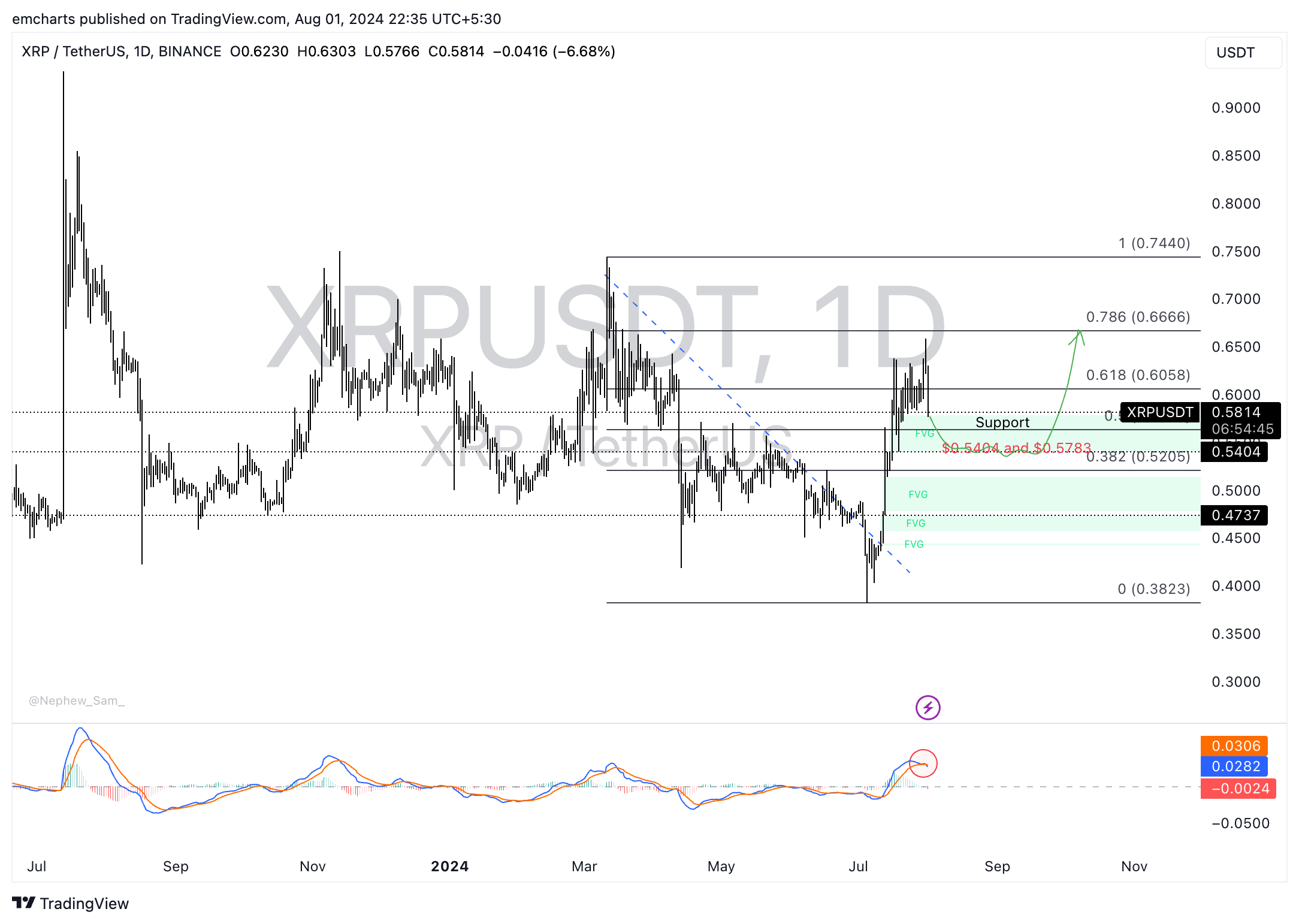Ripple makes strategic announcement, negative sentiment among XRP traders as SEC cancels closed-doors meeting
- Ripple announced the arrival of tokenized US Treasury bills on the XRP Ledger in an official tweet on X.
- XRP trader sentiment turns to fear on the Fear and Greed Index on CFGI.io.
- XRP erases recent gains, suffers nearly 7% decline on Thursday.
Ripple (XRP) informed market participants of the arrival of tokenized US Treasury bills on the XRP Ledger through an official tweet on X. The announcement marks the firm’s strategic move at a time when XRP traders experience the uncertainty of the Securities & Exchange Commission (SEC) lawsuit.
XRP trades above $0.58 at the time of writing, erasing nearly 7% of its value on the day.
Daily digest market movers: Ripple makes key move while lawsuit ruling is awaited
- Ripple revealed that tokenization platform OpenEden Labs is bringing tokenized US Treasury bills on the XRP ledger.
- The payment remittance firm is creating a fund to invest in tokenized T-bills and plans to allocate $10 million to the firm’s TBILL tokens as a part of the initiative.
- Ripple’s announcement failed to catalyze gains in XRP Ledger’s native token, XRP.
News alert – tokenization platform @OpenEden_Labs is bringing tokenized US Treasury bills (T-bills) to the #XRPL! What's more, Ripple is creating a fund to invest in tokenized T-bills, and will allocate USD$10M to OpenEden’s TBILL tokens as part of it. https://t.co/8GsG1Mk3ER
— RippleX (@RippleXDev) August 1, 2024
- XRP traders are fearful, per the Fear and Greed Index on CFGI.io. The sentiment among traders is neutral on the 1-day timeframe, and the indicator shows “fear” is dominant on the four hour timeframe.
- The SEC canceled its closed-doors meeting planned for August 1, per the regulator’s website.
- The cancelation of the closed-doors meeting comes at a time when traders await a ruling in the SEC vs. Ripple lawsuit.
- XRP army member and influencer behind the X handle @BabaCugs says that the regulator has closed its case against Ripple and decided to settle instead of pushing for the $2 billion in penalties.
- The influencer shared their comments in a tweet on X:
The SEC has closed its case against Ripple, ending the legal proceedings that began in March 2024. The case initially sought a $2 billion penalty and an injunction against XRP sales to institutional investors. However, the SEC decided to settle instead of pursuing these remedies.…
— BABA (@BabaCugs) July 31, 2024
- Its important to note that @BabaCugs does not quote a source and shares no evidence of the regulator closing its case.
Technical analysis: XRP loses recent gains, bleeds 7% in one day
Ripple broke out of its downward trend on July 12. Since then the altcoin made steady gains, however in a recent turn of events, XRP suffered a steep correction, nearly 7% drop in a single day.
XRP erased recent gains and dipped to a low of $0.5766 on Thursday. The altcoin is likely to collect liquidity in the Fair Value Gap (FVG) between $0.5404 and $0.5783.
The Moving Average Convergence Divergence (MACD) indicator supports the decline with the MACD line dipping under the signal line. This shows there is underlying negative momentum in XRP price trend.

XRP/USDT daily chart
A daily candlestick close above $0.60 could invalidate the bearish thesis and XRP could rally towards $0.6666, the 78.6% Fibonacci retracement of the decline from March 12 top of $0.7440 to the July 5 low of $0.3823.
Bitcoin, altcoins, stablecoins FAQs
Bitcoin is the largest cryptocurrency by market capitalization, a virtual currency designed to serve as money. This form of payment cannot be controlled by any one person, group, or entity, which eliminates the need for third-party participation during financial transactions.
Altcoins are any cryptocurrency apart from Bitcoin, but some also regard Ethereum as a non-altcoin because it is from these two cryptocurrencies that forking happens. If this is true, then Litecoin is the first altcoin, forked from the Bitcoin protocol and, therefore, an “improved” version of it.
Stablecoins are cryptocurrencies designed to have a stable price, with their value backed by a reserve of the asset it represents. To achieve this, the value of any one stablecoin is pegged to a commodity or financial instrument, such as the US Dollar (USD), with its supply regulated by an algorithm or demand. The main goal of stablecoins is to provide an on/off-ramp for investors willing to trade and invest in cryptocurrencies. Stablecoins also allow investors to store value since cryptocurrencies, in general, are subject to volatility.
Bitcoin dominance is the ratio of Bitcoin's market capitalization to the total market capitalization of all cryptocurrencies combined. It provides a clear picture of Bitcoin’s interest among investors. A high BTC dominance typically happens before and during a bull run, in which investors resort to investing in relatively stable and high market capitalization cryptocurrency like Bitcoin. A drop in BTC dominance usually means that investors are moving their capital and/or profits to altcoins in a quest for higher returns, which usually triggers an explosion of altcoin rallies.

